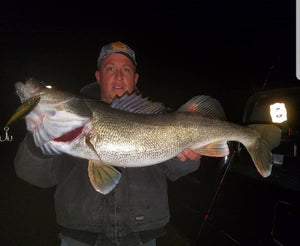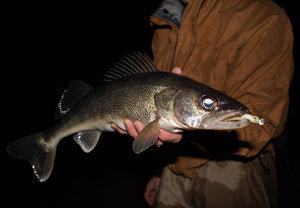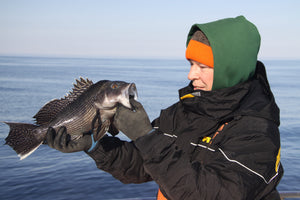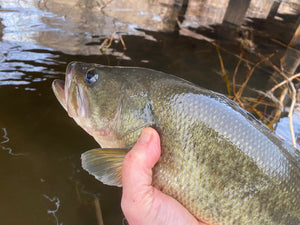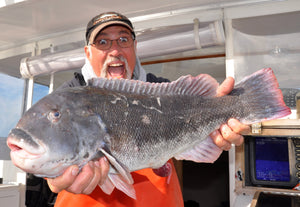Working Up Fall Bigmouths

WORKING UP FALL BIGMOUTHS
By Staff
The fall season has a way of sneaking up on sweetwater anglers. One day you’re tossing weedless frogs across the tops of lush, green weed mats. A few weeks later and the weeds have receded or turned to brown. By the time mid-October rolls around, largemouth bass here on Long Island are already on their cool water patterns. Watch for the signals that mark this changeover and you can stay on the fish right through Thanksgiving. Here’s a few key points to help guide the way.

Photo: © OutdoorTom.com.
PLUG THE GREEN
As thick mats of lush green weeds fade and recede in October, they lose much of their appeal to largemouth bass. Throughout the summer, they provided shade, generated oxygen, and served as ambush points for hungry predators laying in wait while young of the year sunnies, perch and shiners cruised their edges. Now, the sun pierces though to the bottom, the minnows have mostly moved out, and photosynthesis has slowed to a drip, negating most of the reasons bass held in the slop to begin with.
Still, if you search hard enough, it is possible to uncover an occasional puff of green weeds that refuse to give up the fight. Lunker largemouths often gravitate toward such patches. The water is clear by now, so approach any green weeds you detect quietly and with patience. Using six- to eight-pound test spinning gear, toss a small, floating minnow imitation and twitch it gently across the surface before nosing it under with a steady retrieve.
In the summer, you could expect a strike almost immediately, but in the cool waters of early fall, some fish will follow a lure for several yards before deciding to strike. Thus, stay alert even after your plug has made its way a considerable distance. Frequently, hard strikes come just before a lure is lifted from the water.
SEEK OUT TOPWAER ACTION
As the weeds continue to fold through late October, bass remain fairly active and may even go on a surface feeding binge if conditions are right. In fact, with warm falls over the past few years, bigmouths have been hitting surface lures well into November given a day or two of rising temperatures that break the 60-degree mark.
By late October and early November, expect the fish to have moved off completely off the shore and toward the mouths of small, shallow coves. As sunshine warms the water slightly in the late afternoon, poppers and bass bugs can raise these fish to the surface. Generally, the strikes are explosive - but highly aggressive small fish will usually outrace the big ones to your offerings. Still, if you cull through enough shorts, solid two- to four-pounders await.
Think yellow, red or green in terms of productive topwater poppers and bass bugs at this time of year. If the fish are stacked and ready to engage in surface feeding antics, you'll know almost immediately. Thus, make a few casts and move on unless you get instant gratification.

Photo: © OutdoorTom.com.
TARGET THE CHANNELS
By mid-November it’s time to fan out from the cove mouths to take up stations along channel edges and drop-offs. Boaters have a big advantage now as most of the fish have moved well off the banks. But put your rod down, forget about casting for a few minutes, and concentrate on finding and mapping the deepest channel you can locate. On mill ponds especially, this is usually the creek bed that runs from the inlet to the outlet. As you probe each channel discovered, you'll find it sports small bends and pockets. It is in these nooks and crannies that bass stack up.
Once you've located an area that seems to hold potential, work it slowly for a minimum of ten to fifteen minutes before moving on. The fish tend to be a little more spread out now, and with water temperatures continuing to fall, a sluggishness spreads throughout the lake. Patience is now a virtue. Take time to probe each pocket slowly and with purpose using dark colored, three- to four-inch scented plastic worms, Gary Yamamoto Senkos rigged wacky style, or small hair jigs. You'll catch fish sporadically, but some might be of trophy status.

Photo: © OutdoorTom.com.
Keep in mind that because the late fall period is often windy and the fish are slow to take, you'll score best if you turn off the trolling motor or saddle your paddle and quietly anchor at each targeted fishing location. Drift fishing may be easier, but dropping the hook ensures you can work each spot thoroughly. From now until the spring, the slower you go the better your odds of hooking-up.
Fall tends to be a windy period, but it occasionally presents a mellow afternoon and that’s your call to action. Take advantage of warming trends or a spell of Indian summer to get out and fish hard. Chances are you'll find some bass enjoying the reprieve as well.
- Bryce Poyer

